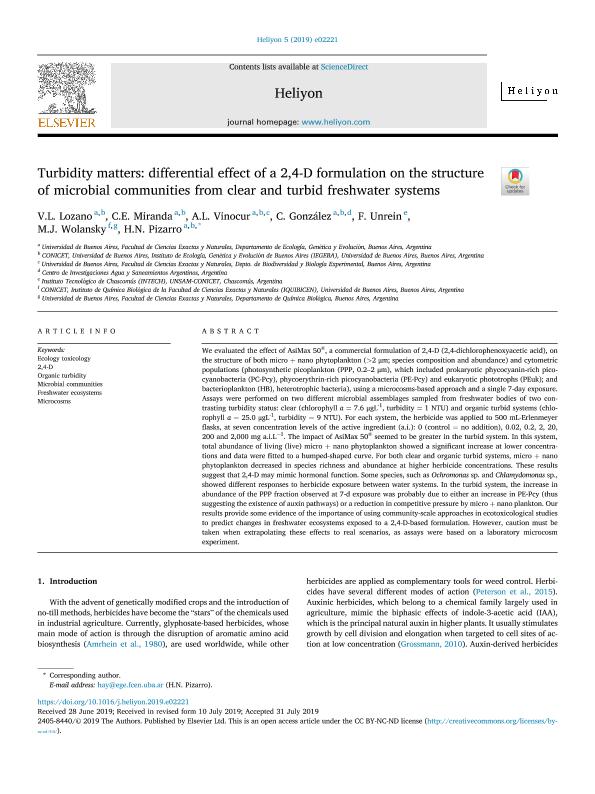Artículo
Turbidity matters: differential effect of a 2,4-D formulation on the structure of microbial communities from clear and turbid freshwater systems
Lozano, Verónica Laura ; Miranda, Cecilia Evelyn
; Miranda, Cecilia Evelyn ; Vinocur, Alicia Liliana; González, C.; Unrein, Fernando
; Vinocur, Alicia Liliana; González, C.; Unrein, Fernando ; Wolansky, Marcelo Javier
; Wolansky, Marcelo Javier ; Pizarro, Haydee Norma
; Pizarro, Haydee Norma
 ; Miranda, Cecilia Evelyn
; Miranda, Cecilia Evelyn ; Vinocur, Alicia Liliana; González, C.; Unrein, Fernando
; Vinocur, Alicia Liliana; González, C.; Unrein, Fernando ; Wolansky, Marcelo Javier
; Wolansky, Marcelo Javier ; Pizarro, Haydee Norma
; Pizarro, Haydee Norma
Fecha de publicación:
08/2019
Editorial:
Elsevier
Revista:
Heliyon
ISSN:
2405-8440
Idioma:
Inglés
Tipo de recurso:
Artículo publicado
Clasificación temática:
Resumen
We evaluated the effect of AsiMax 50®, a commercial formulation of 2,4-D (2,4-dichlorophenoxyacetic acid), on the structure of both micro + nano phytoplankton (>2 μm; species composition and abundance) and cytometric populations (photosynthetic picoplankton (PPP, 0.2–2 μm), which included prokaryotic phycocyanin-rich picocyanobacteria (PC-Pcy), phycoerythrin-rich picocyanobacteria (PE-Pcy) and eukaryotic phototrophs (PEuk); and bacterioplankton (HB), heterotrophic bacteria), using a microcosms-based approach and a single 7-day exposure. Assays were performed on two different microbial assemblages sampled from freshwater bodies of two contrasting turbidity status: clear (chlorophyll a = 7.6 μgL-1, turbidity = 1 NTU) and organic turbid systems (chlorophyll a = 25.0 μgL-1, turbidity = 9 NTU). For each system, the herbicide was applied to 500 mL-Erlenmeyer flasks, at seven concentration levels of the active ingredient (a.i.): 0 (control = no addition), 0.02, 0.2, 2, 20, 200 and 2,000 mg a.i.L−1. The impact of AsiMax 50® seemed to be greater in the turbid system. In this system, total abundance of living (live) micro + nano phytoplankton showed a significant increase at lower concentrations and data were fitted to a humped-shaped curve. For both clear and organic turbid systems, micro + nano phytoplankton decreased in species richness and abundance at higher herbicide concentrations. These results suggest that 2,4-D may mimic hormonal function. Some species, such as Ochromonas sp. and Chlamydomonas sp., showed different responses to herbicide exposure between water systems. In the turbid system, the increase in abundance of the PPP fraction observed at 7-d exposure was probably due to either an increase in PE-Pcy (thus suggesting the existence of auxin pathways) or a reduction in competitive pressure by micro + nano plankton. Our results provide some evidence of the importance of using community-scale approaches in ecotoxicological studies to predict changes in freshwater ecosystems exposed to a 2,4-D-based formulation. However, caution must be taken when extrapolating these effects to real scenarios, as assays were based on a laboratory microcosm experiment.
Archivos asociados
Licencia
Identificadores
Colecciones
Articulos(IEGEBA)
Articulos de INSTITUTO DE ECOLOGIA, GENETICA Y EVOLUCION DE BS. AS
Articulos de INSTITUTO DE ECOLOGIA, GENETICA Y EVOLUCION DE BS. AS
Articulos(IIB-INTECH)
Articulos de INST.DE INVEST.BIOTECNOLOGICAS - INSTITUTO TECNOLOGICO CHASCOMUS
Articulos de INST.DE INVEST.BIOTECNOLOGICAS - INSTITUTO TECNOLOGICO CHASCOMUS
Articulos(IQUIBICEN)
Articulos de INSTITUTO DE QUIMICA BIOLOGICA DE LA FACULTAD DE CS. EXACTAS Y NATURALES
Articulos de INSTITUTO DE QUIMICA BIOLOGICA DE LA FACULTAD DE CS. EXACTAS Y NATURALES
Citación
Lozano, Verónica Laura; Miranda, Cecilia Evelyn; Vinocur, Alicia Liliana; González, C.; Unrein, Fernando; et al.; Turbidity matters: differential effect of a 2,4-D formulation on the structure of microbial communities from clear and turbid freshwater systems; Elsevier; Heliyon; 5; 8; 8-2019; 1-11
Compartir
Altmétricas



